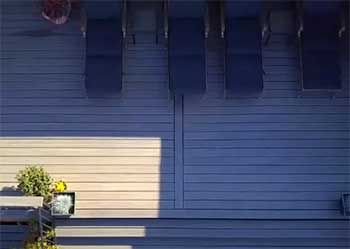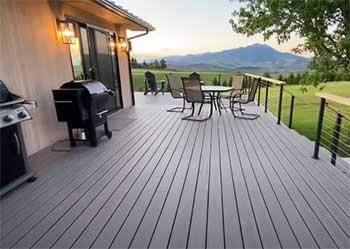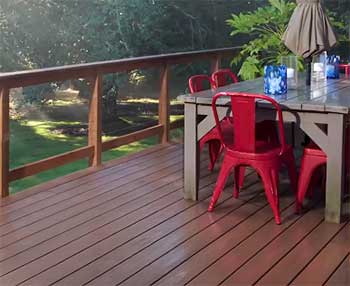Composite decking has become increasingly popular in recent years as an alternative to traditional wooden decks. Two of the biggest brands in composite decking are Sylvanix and Trex.
Both offer high-quality composite decking products that are durable, low-maintenance, and designed to withstand the elements.
But how do Sylvanix and Trex really compare? Let’s take an in-depth look at the key differences between Sylvanix and Trex decking.
A Brief Comparison Table
| Factor | Sylvanix | Trex |
| Materials | Polymer shell + mineral-enriched rice husk core | 95% recycled wood fibers and plastic |
| Durability | Fully encapsulated core resists weathering on all sides | Polymer cap layer on 3 sides resists fading and stains |
| Appearance | 5 natural wood color options | 9 diverse color options |
| Cost | $3.50 – $4.50 per linear foot | $2.30 – $3.50 per linear foot |
| Warranty | 50-year structural warranty, 25-year stain/fade warranty | 25-year stain/fade warranty, 25-year residential replacement |
| Eco-Friendliness | Uses agricultural byproduct (rice husks) | Made from 95% recycled materials |
| Climate Performance | Fully enclosed shell provides optimal protection | May be more prone to expansion/contraction without bottom coverage |
Overview of Sylvanix Decking
Sylvanix is a relatively new brand of composite decking that was first introduced in 2018. It is manufactured by a company called Synthesis Agri-Tech Composites using a process they have patented called Shell + Core technology.
Here are some of the key features of Sylvanix decking:

- Made from a mix of plastic and rice husks
- Has a solid polymer shell surrounding a mineral-enriched core
- Provides enhanced stain, scratch, mold, and mildew resistance
- Offers a natural wood look with realistic grain patterns
- Available in 5 colors: Coastal Grey, Brownstone, Brick Red, Sandy Birch, and Brazilian Walnut
- Capped on 4 sides for durability
- Slip-resistant and splinter-free
- 25-year stain and fade warranty
- 50-year structural warranty
Sylvanix touts their Shell + Core technology as what sets their decking apart from other composites. The polymer shell provides protection from the elements while the mineral core gives the boards rigidity and strength.
Overview of Trex Decking
Trex is one of the most well-known and popular composite decking brands on the market. The company first introduced their decking products in the mid-1990s and have continued to innovate over the years.
Here are some key features of Trex decking:
- Made from a mix of reclaimed wood and recycled plastic film
- Has a protective polymer cap layer on top
- Resists stains, scratches, fading, mold, and mildew
- Realistic wood-like look with grain patterns
- Available in 9 colors: Gravel Path, Rope Swing, Beach Dune, Clam Shell, Saddle, Spiced Rum, Lava Rock, Island Mist, and Vintage Lantern
- Capped on 3 sides
- Slip-resistant and splinter-free
- 25-year stain and fade warranty
- 25-year removal and replacement warranty
Trex uses a mix of 95% recycled wood and plastic film to create their boards. The polymer cap layer helps protect against weathering.
Now that we’ve taken a high-level look at both brands, let’s directly compare the pros and cons of Sylvanix vs. Trex.
Key Differences Between Sylvanix And Trex Decking
There are several important factors to consider when comparing Sylvanix and Trex decking:

- Composition of materials
- Durability
- Appearance
- Cost
- Warranties
- Performance in different climates
- Eco-friendliness
- Safety
Looking closely at how Sylvanix and Trex stack up across these factors will provide a good overview of their relative strengths and weaknesses.
Composition of Materials
One of the biggest differences between Sylvanix and Trex is in the materials used to make their composite decking boards.
Sylvanix uses a Shell + Core design with:
- Outer shell made from polymer
- Inner core made from mineral-enriched rice husks
Trex uses:
- Mix of 95% recycled wood and recycled plastic film
- Protective polymer cap layer
The unique Shell + Core technology is one of Sylvanix’s biggest selling points. The polymer shell surrounds and protects the mineral-enriched rice husk core, which Sylvanix claims provides enhanced durability and performance.
Trex utilizes a more traditional composite makeup of recycled wood fibers and plastic. The plastic gives it durability while the wood provides a natural look.
Durability
When it comes to durability, both Sylvanix and Trex are excellent options that can withstand harsh weather conditions and everyday wear and tear. However, there are some differences:
- Sylvanix touts their Shell + Core technology as providing unmatched stain, scratch, and mold resistance. The polymer shell completely encases the core on all 4 sides.
- Trex has a polymer cap layer that resists fading, stains, scratches, and mildew. However, the cap layer only covers the top and sides of Trex boards, not the ends.
Both composites are slip-resistant and splinter-free. The Sylvanix shell fully covers the core while Trex has an uncovered bottom, so Sylvanix may have a slight edge in terms of long-term durability. But both should perform well for decades.
Appearance
Sylvanix and Trex both offer realistic wood looks and grain patterns that make them hard to distinguish from real wood decking.
Sylvanix is available in 5 natural wood colors:
- Coastal Grey
- Brownstone
- Brick Red
- Sandy Birch
- Brazilian Walnut
Trex provides a wider range of 9 color options:
- Gravel Path
- Rope Swing
- Beach Dune
- Clam Shell
- Saddle
- Spiced Rum
- Lava Rock
- Island Mist
- Vintage Lantern
Trex certainly wins when it comes to number of color choices. Trex and Sylvanix have fairly comparable grain patterns. So neither seems to have a strong advantage in appearance – it mainly comes down to personal color preference.
Cost
When comparing cost, Trex consistently comes in at a lower price point than Sylvanix:
- Sylvanix boards cost around $3.50 to $4.50 per linear foot.
- Trex boards range from $2.30 to $3.50 per linear foot.
So Trex is generally 10-20% cheaper than Sylvanix for most comparable decking board options.
Trex’s lower cost can be attributed to a few factors:
- As an established brand, Trex benefits from economies of scale.
- Trex uses lower-cost recycled wood fibers rather than mineral-enriched rice husks.
- Sylvanix touts proprietary Shell + Core technology that adds manufacturing costs.
Install costs may also be lower with Trex since it is a more familiar product for contractors.
Warranties
The warranties offered by Sylvanix and Trex back up their claims of long-lasting durability:
- Sylvanix provides a 50-year structural warranty and a 25-year stain and fade warranty.
- Trex offers a 25-year stain and fade warranty. For residential use, Trex provides a 25-year removal and replacement warranty.
The Sylvanix 50-year structural warranty gives it a strong advantage over Trex’s 25-year residential replacement warranty. Longer coverage means added peace of mind.
Both warranties cover defects in materials and workmanship. Proper installation and care are required to maintain the warranty. Overall, Sylvanix provides longer and potentially more comprehensive warranty coverage.
Performance in Different Climates
Both Sylvanix and Trex are designed to withstand tough weather conditions including sun, rain, snow, and ice. Their durable polymer shells prevent moisture absorption.
However, Sylvanix may have a leg up in certain climates thanks to its fully enclosed Shell + Core design. With the core shielded from all sides, it may better withstand temperature swings in very cold or hot climates compared to Trex’s uncovered bottom.
Trex performs very well across a range of climates too. But the lack of bottom coverage could potentially allow more expansion and contraction in extreme cold and heat over decades of use.
Eco-Friendliness

Going green is a priority for both of these composite decking brands. Their use of recycled materials diverts waste from landfills.
Sylvanix uses rapidly renewable rice husks as their core, giving them an eco-friendly advantage.
Rice husks would otherwise be discarded, so using them in decking gives this agricultural byproduct new life.
Trex uses 95% recycled materials including reclaimed wood.
They keep over 400 million pounds of plastic film and wood scrap out of landfills each year.
Both Trex and Sylvanix avoid using harmful chemicals in production. And neither contains toxic ingredients like arsenic that can sometimes be found in pressure treated lumber.
Overall, Sylvanix likely gets a slight green advantage by repurposing rice husks in their innovative Shell + Core boards. But both brands are far more eco-friendly than traditional deck lumber.
Safety
In terms of safety underfoot, Sylvanix and Trex are nearly identical. Both offer enhanced slip resistance for better traction compared to wood decks.
The durable composite materials are splinter-free, avoiding the cracks and splinters that can happen with real wood. This makes them safer for kids and pets.
Neither decking option gets hot to the touch in sunny weather the way some other deck materials can.
When dry, the textured surfaces provide sure footing. Both Sylvanix and Trex meet code requirements for slip resistance. Safety is not a point of differentiation.
Which Is Better For Your Deck?
Now that we’ve compared the key factors, let’s summarize the main pros and cons of Sylvanix vs Trex:
Sylvanix Pros
- Fully encapsulated core for enhanced durability
- Longer 50-year structural warranty
- Made with eco-friendly rice husks
- 5 natural-looking color options
Sylvanix Cons
- Higher price point
- Fewer color choices than Trex
- Newer product with less brand recognition
Trex Pros
- Lower cost
- More well-known and established brand
- 9 diverse color options
- Made from 95% recycled materials
Trex Cons
- Polymer cap layer doesn’t fully enclose bottom
- 25-year residential warranty
For many homeowners, Trex is likely the better overall value given its lower upfront cost and competitive durability and appearance. Trex’s wide color selection and renowned reputation are also attractive benefits.
However, if your budget allows, Sylvanix offers enhanced long-term durability thanks to the fully enclosed Shell + Core boards. For homeowners prioritizing eco-friendliness, Sylvanix’s unique use of rice husks gives it an edge.
Frequently Asked Questions (FAQ)
Sylvanix is comparable to Trex and offers enhanced durability thanks to the fully encapsulated Shell + Core boards. Other brands like TimberTech and Fiberon also offer quality composite decking alternatives. But Trex remains a top brand with proven performance and attractive pricing.
Some cheaper composite decking alternatives to Trex include: EverNew PT decking, Rhino Deck, ChoiceDek, MoistureShield, Deckorators, etc.
These tend to cost 20-30% less than Trex. But they may not match Trex’s durability and stain/fade warranties.
Trex, TimberTech, and Fiberon are among the top brands in composite decking. Sylvanix is a newer option that offers enhanced durability. Consider warranties, price, appearance, and brand reputation when choosing the best decking for your needs and budget.
Sylvanix decking features a polymer shell surrounding a core made from mineral-enriched rice husks. This proprietary Shell + Core design provides weather protection and durability. The polymer shell resists stains, scratches, and fading while the rice husk core offers stability and stiffness.
Final Thoughts
Ultimately there is no “wrong” choice between these two quality composite decking brands. Your needs and preferences will determine which is better suited for your decking project. Consider cost, durability, warranty coverage, appearance, brand reputation, eco-impact, and other factors important to you.
To see the products in person, request free samples from Trex and Sylvanix to compare color and grain patterns firsthand. And consult with knowledgeable deck contractors to get their expert recommendations on which option may work best for your specific deck.
With the right composite boards, you can enjoy decades of stylish, low-maintenance outdoor living. Both Sylvanix and Trex will transform your backyard with their wood-like beauty and extreme weather resistance.
